P.N. Sharma was a reporter for the well known weekly magazine the BLITZ being published from Bombay. He was one of the first war correspondents on scene in Kashmir during the 1947 airlift of troops to Kashmir. His 1957 book, Inside Occupied Kashmir is not well known, but is a rare insight of some of the first combined operations of the war. Sharma’s adventure started with his being on a public relations joyride in one of the IAF’s Harvards. This account tells what happened on that fateful day.
On November 29, 1947, I reached Jammu where I stayed at the Press Camp along with other Indian and foreign correspondents The raiders in Jammu area were very strong and were actually threatening jammu cur. They were running amuck, killing, burning and looting village”. Refugees were pouring in their thousands into Jammu from various directions on foot. They were carrying with them whatever little they could save. The pilots of the RIAF stationed in Jammu who were very busy strafing and bombing the raiders reported that they could see miles-long convoys of refugees inside the lines held by the Indian Army and the State Forces. On the other side of the lines they could see the raiders in strength of thousands burning the villages. Some of the villages were already reduced to ashes while in some others the fire still raged. Reports from forward areas and first-hand information from the refugees showed that the raiders were burning men, women and children indiscriminately.
On December 1, 1947. at about 12 noon. by the courtesy of the RIAF, through the Public Relations Officer, Lt. Col. Pyara Lal, I took off in a Harvard to shoot some pictures in the forward area. I was equipped with my Filmo-camera 16 mm, and Rolleiflex and Leica cameras. Before the take-off, I was introduced to Flying Officer D’Cruz by the Air Liaison Officer at the Jammu airfield.
Flying Officer Ulrich D’Cruz, known as Dick, took me to the Air operations tent where I was introduced to all the other pilots and the Flight commander. We had tea together and smoked a cigarette. I was then made to sign a ‘Blood Chit’ known as an ‘Indemnity Bond’. Dick then took me to an aircraft, jumped into the cockpit and strapped me to the seat together with a parachute. The straps were slightly loose and so Dick told the airman present to fasten the straps properly which they promptly did. It was then that Dick gave me a briefing on signals in ease our inter-communications failed, or for some case of emergency. I had a pilot’s helmet on complete with head-phones. The engine started full boost. Dick gave me the O.K. signal, ‘thumbs up’ and we took off.
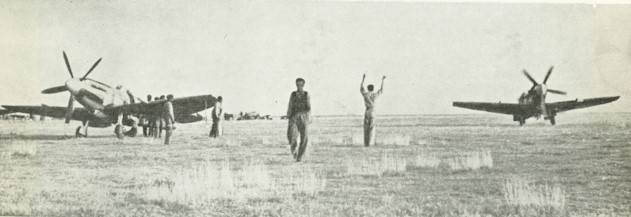
PN Sharma’s photo of Spitfires from Srinagar airfield has not been published elsewhere apart from his book. To this date, this is the only existing photograph of the IAF’s Spitfire XIVs operating from Srinagar airfield.
During our reconnaissance we came across a village on fire and surrounded by raiders. Dick dived down, strafed the raiders, killing a a few. I was busy taking my pictures and we finally dispersed them Then we flew along to another spot within Jammu border. Suddenly I heard a roaring noise and whistle passing by on our left. It was caused by one of our own Tempest fighters which had dived down to get their kill. While we flew along we were at an altitude of about 3,000 feet.
We were looking down right and left. I saw a large hand of Pathans carrying loot and ammunition on donkeys and camels. This was what we were looking for. I got my cameras ready again and started shooting while Dick dived down and strafed. We succeeded in killing a few again and wounding some others and after we had pulled up and looked around, we saw some more raiders running. Dick smiled dived down again and strafed. During our dive I felt some vibrations. I saw some smoke on the starboard of the plane and suddenly the engine stopped. I felt that we were fast loosing height – Dick gave me the ‘Thumbs’ down signal. I felt that something was pulling me against my wishes at a terrific speed. Blood went up my head, eyes, lips, teeth and ears were jamming. I felt 4Gs or 5Gs, an air force term for gravity. All this happened in the course of a few seconds. I was feeling blacked-out but even in that state I could perceive the plane hitting against something hard, probably a rock bumping and then dashing into a tree when it stopped dead.
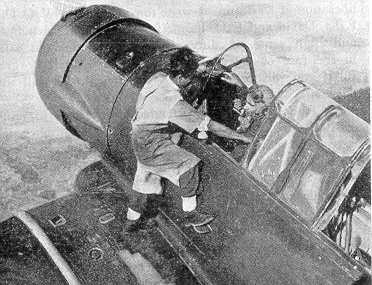
A ground crew member of the IAF gives the pilot of a Harvard inputs moments before the aircraft is to take off for a sortie against the tribal raiders.
There was complete silence for a few seconds. It was only in a subconscious state that I thought Dick was dead and that I was dead too. Apparently Dick thought the same. The plane was catching fire, but fire had not quite reached the cockpit. I was fiddling to open my straps and parachute belt. It was then that Dick shouted. “Joe, are you all right?” I replied yes and said. “Are you OK?”
After all, we were alive for each other We both managed to undo our straps as quickly as possible, the flames were by then about to engulf the cockpit. I took my cameras out while Dick tried to pull out his map. I started filming and snapping our crashed plane which was in flames. Suddenly there was a big explosion. The tank had exploded. While we were hurriedly looking at the map and compass to find out the direction in order to make a dash on foot for our advance Brigade headquarters. about five or seven miles away from the site of our crash. Suddenly a rifle shot rang past us. It seemed to come from amongst the bushes which were three to four furlongs from the spot where we stood in utter distress.
As soon as we heard the shot, we took positions and Dick answered with his revolver. We saw a man running with a rifle in his hand. We ran towards our advance Brigade headquarters in the opposite direction. We had only run just about three-quarters of a mile when someone again fired at us. We again took cover for a short while and resumed our race towards our destination. but this time in a zigzag way. While we were running zigzag we were fired at from various directions. We ducked every time and when silence prevailed we ran again. Never before or after that fateful moment have I run so fast as I did then. Definitely the idea that life and freedom depended on the dash across a few miles, had given me the strength of a giant. Later, in happier moments, I have often recalled that if that run of mine had been counted for the world Olympics, I would have done better than Zatopeck.
I could see the raiders firing at us. The bullets were missing us narrowly and while we were still running in a zigzag way desperately trying to reach our advance headquarters, the raiders came out from among trees and hushes and encircled us closely. They were still firing at us. We could hear the bullets whistle past our ears and could see them falling just a few inches ahead of our feet, raising dust from the ground. We saw some policemen and tribesmen on horseback and decided in a hurried short-of-breath conference that there was not much hope in running. We stopped short and raised our hands. They were still firing at us and we ducked again. When the firing stopped, we rose to our feet. Two Pakistani policemen came galloping on their horses and with their rifles aimed at us. Dick immediately hid his revolver in the ground.
The two Pakistani policemen were in their uniforms. One of them was a Havildar. He dismounted from his horse, while the Sepoy kept his rifle aimed at us. The Havildar searched us, and having found no arms with us, asked the other Sepoy to dismount. They took my cameras, my press card, gold watch, gold cigarette case, cash and other valuables from me and Dick’s valuables too. They went to the extent of removing our pants and shirts and other garments, though they were kind enough to leave us with our underpants and vests. They mounted their horses and carried with them our personal effects that they had looted. Dick and I stood there grinning at one another and wondering what was to follow.
Soon a hand of Pathans tribesmen on foot approached close by and a few of them dashed towards us. Two of them removed their turbans from their heads and using these turbans as ropes tied our hands behind our backs. They all shouted and yelled in ‘Pushto’ and in broken Punjabi which I managed to follow. Dick hailing from the South could not quite make out what they were shouting about. I told him that they were cursing us using the words ‘Da Kafir’ and ‘Da Dogra.’ We did not answer them. They wanted to know exactly who we were. I had asked Dick in Punjabi whether he was a Dogra or a Muslim which I translated to him in English. Dick said ‘Allah’ which in Islam means God. They then left Dick, came up to me and asked me who I was. I tried to change the subject saying that I was a newspaperman which had to translate in Urdu, as ‘Akhbar’ which sounded like Akbar, another name for ‘Allah’ God.
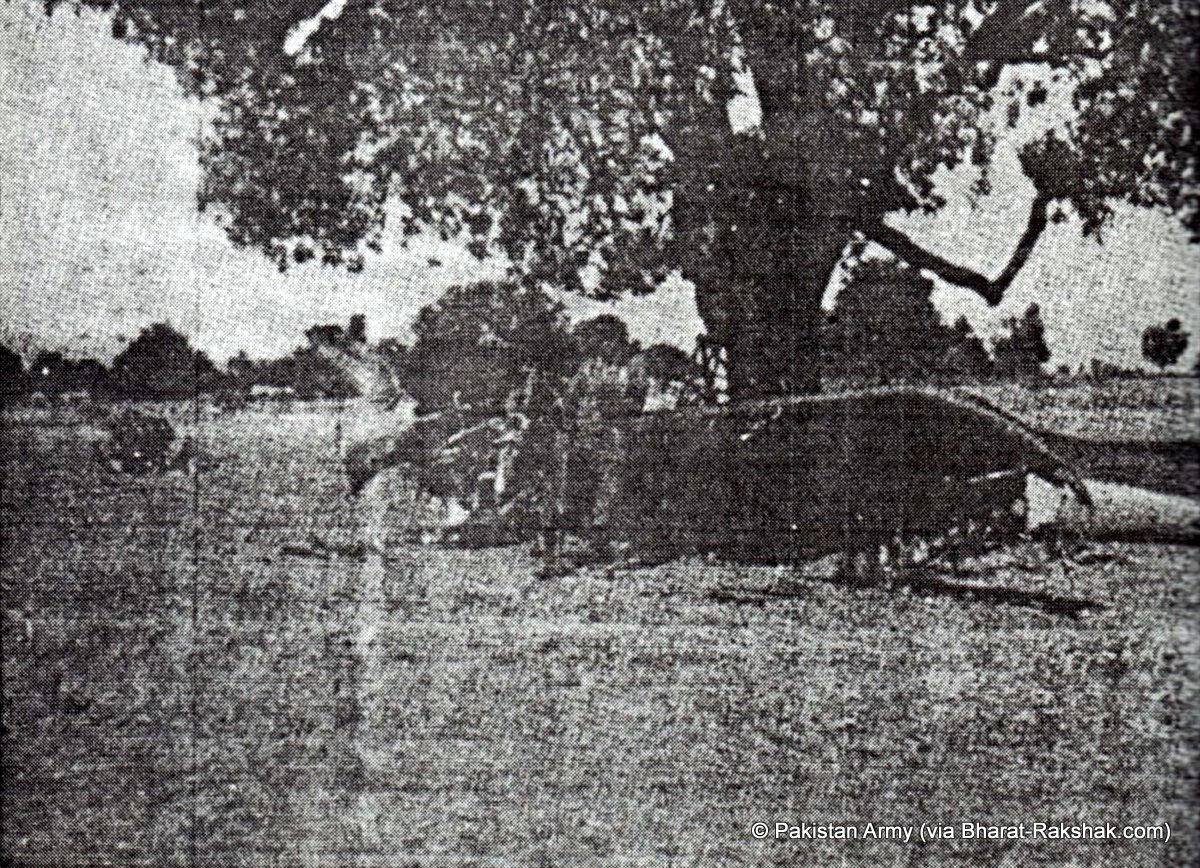
A very poor quality photograph, taken from the Pakistan Army’s Official History – shows the wreck of an unidentified Indian Air Force Aircraft “shot down by rifle fire near Assar”. The wing profile matches that of a North American Harvard trainer – giving rise to the theory that this was the same aircraft that Ulrich D’Cruz was flying during that fateful sortie.
They could not quite understand what we were trying to say but all they could follow was that we were saying something about Allah and Akbar. They held their patience with us and decided to take us to their ‘Pir Sahib’ the religious head. We were first marched to our aircraft which had by now burnt to ashes, together with the tree it had hit. We saw the engine which had rolled out about twenty feet away and scattered all over, and pieces of the propeller and other parts of the aircraft were lying all over the place. The Pathans tired several rounds at the burnt out ashes of the aircraft and shouted at the top of their voices ‘Da Khuda Ka Bachha’ (Son of God). We were then made to march to a nearby village named Asar. While we were being marched towards this village, another hand of Pathans shouting and screaming in Pushto came towards us and announced its intention to kill us. We could not understand what they were saving; I could only guess that they were wanting to kill us. Those who had captured us told them that they would first take us to their Pir Sahib. Interrogate us and only then kill us. The other band insisted that if our captors did not kill us, they would. There followed a hot argument between the Maliks (leaders of the gangs) of the two bands. The Malik of the first band ordered his men to fire at the other band and our band succeeded in killing one man from the other party. As soon as this happened, the other party who were on horsebacks, galloped away and Dick and I were left at the mercy of the first band.
While we were going towards the village our hands tied at our backs, the Pathans guarded us on all hides, front and back, right and left. Ahead of us they danced clockwise and anti-clockwise shouting, Allah-Ho-Akhar, Pathanistan Zindabad, Pakistan Zindabad, etc., etc., and at the end of each clockwise and anti-clockwise dance movement, they were firing shots in the air as a sort of celebration of their victory over us. They were very proud of having captured us. They looked extremely jubilant. Meanwhile, a few Punjabi raiders came along and started kicking both of us at our hacks and hitting us with rifle butts and barrels on our heads, knees, jaws, ribs and other joints. They hit us mercilessly and cursed us profusely. Our knees were almost broken and every time they kicked us at our backs so hard that repeatedly we fell face-long on the ground. We, however, did not cry or yell at all though we were being kicked almost to death. The Pathans who had captured us did seem to fact some sympathy far us as they told the Punjabi raiders not to beat the prisoners. Such beating, they said. was against Islamic principles but the Punjabis did not seem to care for the words of the Pathans, and carried on with their hitting and abuse. Then the Pathans got into a temper and told the Punjabis that if they did not leave us alone, they would kill them and aimed their rifles towards the Punjabis. Thereupon the Punjabi raiders left us and went away. Limping slowly we reached the village Asar.
We paused by the village huts and a small mosque. The mosque was doorless, so we could see inside it a couple of 20mm guns and some regular Pakistan Army personnel. The Sepoys had insignia of 14th Punjab Regiment on their shoulders. We later discovered that our plane was shot down by these guns that were in the mosque. Some of the village huts were also occupied by the regular Pakistan Army. It appeared to be the Company headquarters of 14th Punjab. We do not know which battalion it was.
Then the Pathans took us to a hut. While we were being taken there, the Pathan Malik and the Pathans were greeted by the Pakistan Army personnel. When we reached inside the hut we thought the Pathans were taking us to their Pir Sahib, but inside was looted property and ammunition and innocent Muslim and Hindu women; a few of them started crying on seeing us blood-stained and with only underpants and vests, our hands tied at our backs. The Pathans were somewhat kind and asked us to sit down. Then started a stream of visitors, regular Pakistan soldiers, civilians and tribesmen. They all wanted to look at us; some cursed us and some were contented only with a peep at us. The Pathans proudly told them that we were their prisoners. They also told them that they were going to take us to their Pir Sahib without further loss of time. They told the Pakistan soldiers to go away straight from there and not to have any more loose talk. Inside the hut we could see the Pathans making forcible lascivious advances to the abducted women who were in a miserable condition, were half-naked and were shivering in cold. Then the Pathans Malik came and shouted some order to the Six Pathans, who then took us out of the hut. We thought that they would probably shoot us now.
We walked to the huts where the Pakistan soldiers were housed by the side of a Kachha track. We saw a command car belonging to the Pakistan Army. The Company commander of the 11th Punjab saw the Pathans off in that very car. The car was being driven by a Pakistan Army driver. The Pathan Malik and one Subedar together with four other Pathans were put on guard duty; two men sat next to each of us, while two others sat in front with rifles aimed at us. Our hands were still tied at our back.
Repatriation – an Year later
During this period I was again visited by two more correspondents and the same story of good rations and good food was repeated just before these two correspondents arrived. These two were also known to me in India. They were Mr. Britter of the ‘London Times’ and Mrs. Britter (the famous Margaret Parton) of the ‘New York Herald Tribune”. They had brought cigarettes, soap and some candy for me. I must say it was sweet and nice of them to have thought of me and I shall not forget the visit of these foreign correspondents. These two correspondents brought a new ray of hope to me. They told me that there were chances of my repatriation.
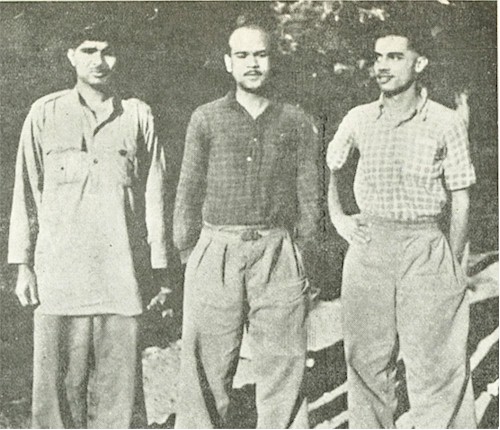
The IAF PoWs at their jail in Attock fort. Fg Off U D’Cruz is on the right, with PN Sharma, the war correspondent in the center. At left is Shri Michael D’Souza, a civilian, who was taken POW during the battle of Jhangar.
They told me I might be exchanged for a Brigadier Rehmatullah who was a prisoner in Srinagar, Kashmir (India). I was overjoyed to hear this news but it seemed too good to be true since Dr. Wenger of the International Red Cross had been trying for my repatriation for the past six months and had not succeeded in his several sincere and hard attempts. But all the same I expected some better luck was coming since I had started receiving money and visitors who had specially come to see me and helped me. That really raised up my morale.
Two day’s later Dick and myself were asked to pack up and be ready to go early morning. We were told that we would be flown from Rawalpindi to India the next morning. We still could not believe it. So we did not care at all and just had a hearty laugh. But Thapa (Lt. Col. K.S. Thapa) and everybody else did take it to be true and they started congratulating us. We still thought it was a big joke on us, but the commander again came and we were taken out of our cage to the hospital. We were weighed there and our doctors were asked to give a medical certificate of fitness. I saw Michael there who was also told to pack up and accompany us. Now we got half sure of going home but did not know what might happen at the last moment, as the Pakistan people often changed their mind and never kept words. I had fixed up code words with Col. Thapa for writing letters. I promised to everyone of the officers and men that if I go home I shall do my very best to send them the Red Cross aid and then arrange to get them repatriated as early as possible.
It was bitterly cold the next morning on December 2, 1948. We were woken up at 4 am. We were put in a 3-ton truck and once again Dick, myself and Michael started moving together. We inhaled the fresh air outside the Attock Fort. We were joyous and were awaiting to be liberated. All of a sudden the truck turned cross-wise and drove over a donkey; we nearly missed an accident. It was raining and the truck was skidding since the driver was driving it too fast. I was shivering in bitter cold because I had no woollen clothes at all. It was exactly a year and a day ago when I was captured and was taken prisoner, and was just as cold as it was on the day when I was captured. But now I was used to the cold and could not care less. We drove about 20 miles towards Rawalpindi. The rain had stopped. The road had dried up and we were driving fast and all of sudden the truck and all of us went into a ditch 20 feet below off the road. The truck crashed into pieces. Our guards and everyone else got seriously hurt. But Dick and I were both all right except that we got a few bruises and a few bumps, practically about as much that we got in our plane crash. Soon after immediately we jumped out of this crashed truck. No one was killed even the driver was all right. But the truck was very badly damaged and was unserviceable. So the Camp Commander and the accompanying Captain, who was attached to this fort as an Intelligence & Censoring Officer, together with our guards decided to walk on the road and get another transport on the road, get a train or something.
We walked about three miles early morning in freezing cold but we were now getting warmed up. We met some Army transport on the road, the Camp Commander halted the transport and we were all loaded into one truck once again and moved on. This time we got through the city of Rawalpindi and the Rawalpindi Cantonment and then to Chaklala airfield in Rawalpindi. There were strict security measures at the Chaklala airfield. All the hangars were closed and I did not see a single airman or pilot or any aircraft at all at the airfield. Our truck drove alter a proper security check by the Air Force police. We were told that the aircraft would he here 10 o’clock and we would leave.
It was here that we met Dr. Wenger of the International Red Cross. Dr. Wenger delivered me some parcels, letters and some more money that he had brought from India for me and for Dick and for Michael. But now since we were being liberated, we did not care any-thing about it and we took charge of the parcels, opened our letters which were censored once again on the spot. The parcels we did not open in order to carry them back with us. One of the parcels contained sweets and other eatables which I sent through Dr. Wenger to the Attock Fort to be given to the rest of the officer prisoners, Col. Thapa, etc., with whom I had lived. It had started raining again and I felt very chilly once again. We waited and waited till 1 o’clock and there was no sign of the plane and the weather was so bad, visibility zero, that no plane on the earth would fly or land without proper anti-fog and radar equipment.
So we had both started praying that nothing should delay or disturb our liberation that morning. We were rather apprehensive that anything might happen at the last moment; the plane may come, may not come due to bad weather and once again we might have to go back to the Attock fort. Group Captain Asghar Khan and Wing Commander Akhtar Khan of the Pakistan Air Force met us. They told us that Brig. Rehmatullah was their father and they had come to see him. And that I would be liberated in exchange of him and a few minutes later met the famous Major Aslam who had fought the Indians in Baramulla and later in various other sectors in Kashmir. Major Aslam was also the son of Brig. Rehmatullah. I saw Major Aslam using my cameras that were looted from me by the regular Pakistani border police during my capture. But here I could not say anything since I was being liberated and if I made any fuss about my cameras, they might hold me up.
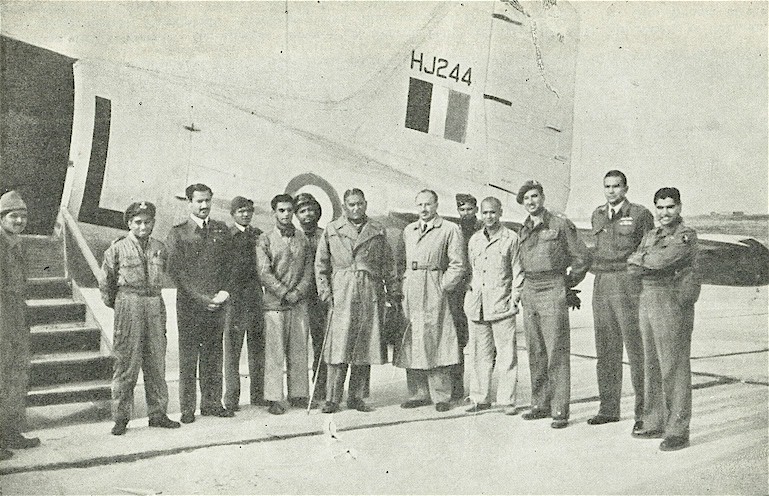
The repatriation of the IAF PoWs. Mr. PN Sharma is fourth from the right. Fg Off Ulrich D’Cruz is fifth from left. Also seen in the picture is Group Captain Asghar Khan of the PAF, third from the left. Also seen in the picture is Mr. Otto Wenger, sixth from right, of the International Red Cross who arranged the transfer.
At about 2.30 p.m. I heard the drone of a plane which sounded like a C-47. Group Captain Asghar Khan went to the control tower and spoke to the plane. They told us it was an Indian Dakota, that they had brought their old man and that we were going home too. We were getting extremely joyous; our faces were red with excitement and happiness. All the chill on my body had gone away and I started feeling free the moment I saw the tricolour markings of the Indian plane that had just landed and was now approaching fast. taxiing towards us. The plane halted, the Indian crew came out, fixed the ladder and came out. The old man properly dressed with a felt hat, an overcoat, a rain coat and a stick in his hand, and three boys rushed to meet their father. Dick and I spoke to the crew of the plane. Dick knew all the pilots. We were introduced there. The Captain of the plane got signatures on a paper about the delivery of the old man to Pakistan and signed for us. We got into the Indian plane and took off and as soon as we took off, I cannot explain how happy I felt in the Indian plane and flying once again in the free air towards home.
We have no idea as what happened to Mr. P N Sharma after he published his book. In October 2010, we received an update from a visitor
P N Sharma was a dear friend of my parents. I grew up knowing him, and am happy to be able to give some information about him. (Regrettably, I don’t have a copy of his book.) Mr Sharma (PN to his friends, PN Uncle to us) continued to be an independent photo journalist. He lived in Delhi, in Chanakyapuri (DII/367 Vinay Marg). He was warm, sociable and a good friend. We remember fondly the many happy evenings we spent with him, in his home or ours. He was single, except when he was briefly married to a Russian lady. We used to meet his mother, brother and two nieces frequently in his home. We knew about this experience, but he never spoke about it.We saw him as a kindly, smiling uncle. He passed away in the early 1970’s.
Flying Officer Ulrich D’Cruz after his repatriation was awarded the Ashok Chakra Class II (later known as Kirti Chakra) in 1950 for his fortitude and resistance against the torture and abuse shown during his period of incarceration by the Pakistani irregulars. D’Cruz migrated to Australia after retirement. He passed away in April 1999.